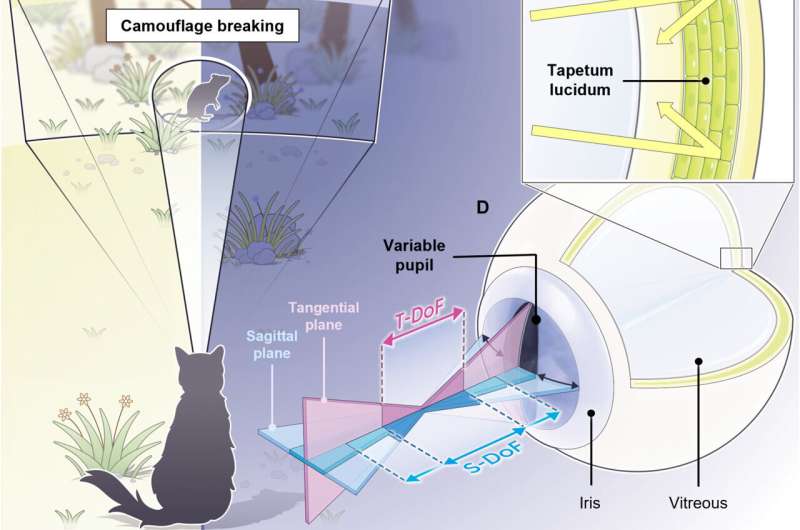
A team of engineers from the Center for Nanoparticle Research, Seoul National University, the Gwangju Institute of Science and Technology and the Korea Institute of Science and Technology, all in Korea, has developed a new type of artificial eye based on natural cat eyes.
In their study published in the journal Science Advances, the group copied two features of cat eyes that give them unique abilities to see in the dark and to detect camouflaged objects.
As the researchers note, cameras installed on drones and robots are based on circular apertures that mimic the human eye, an approach that results in imagery with both a foreground subject and the background kept in focus. This approach sometimes makes it difficult for the camera to keep track of the target object.
Animals, such as cats, use a different approach: They have vertically slitted eyes to capture an asymmetric depth of field. Because of that, the researchers chose to use the cat eye architecture as a means for developing a new type of artificial eye.
Using animal eyes as a template for designing new types of artificial eyes is nothing new, of course—last year, another team of researchers in Korea used the cuttlefish eye as inspiration for the design of a robot eye that could see better in murky, underwater conditions.

For the new approach, the research team designed a vertical aperture, allowing the camera to keep a target in focus while the field behind it remained blurry, allowing for better tracking of target objects during the day.
Cats can see well at night because they have a tapetum lucidum—a reflective layer behind the retina that improves light sensitivity. It is also responsible for making cat eyes appear to shine at night. The researchers gave their artificial eye the same abilities by adding silver metal reflectors behind the image sensor.
Together, the two features give the new camera the ability to see better in the dark and to keep track of target objects, even if they are hidden by camouflage.
More information:
Min Su Kim et al, Feline eye–inspired artificial vision for enhanced camouflage breaking under diverse light conditions, Science Advances (2024). DOI: 10.1126/sciadv.adp2809
© 2024 Science X Network
Citation:
Scientists mimic cat eyes to create artificial eye that sees better in the dark, detects camouflaged objects (2024, September 19)
retrieved 26 September 2024
from https://techxplore.com/news/2024-09-scientists-mimic-cat-eyes-artificial.html
This document is subject to copyright. Apart from any fair dealing for the purpose of private study or research, no
part may be reproduced without the written permission. The content is provided for information purposes only.


